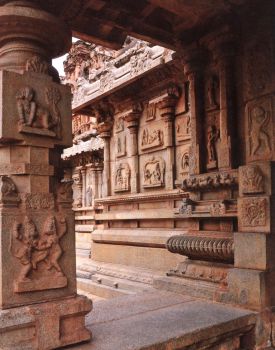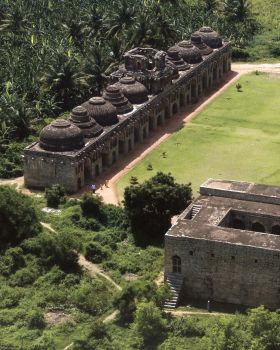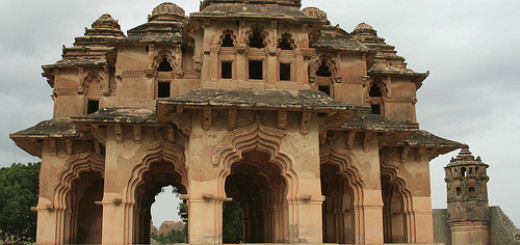Major attractions at Hampi

Scenes from Ramayana are carved on the walls of Ramachandra Temple.
Hampi is an ancient town situated on the southern bank of the river Tungabhadra. It was the capital of the mighty Vijayanagara Empire.
Hampi was built upon the instructions of the sage Vidyaranya. Because of this reason it is also called Vidyanagara. Work on this city started in AD 1336 during the reign of Harihara-I. Most of the royal buildings that we see today were built by Krishnadeva Raya who ruled the city from AD 1509 to 1530. During the reign of the Vijayanagara kings, there was a resurgence of art, architecture and Hindu religion. Chroniclers from countries like Italy, Arabia, Russia and Portugal had visited Hampi during the peak of its glory.
Hampi covers an area of 26 sq km. There are seven lines of fortifications around the city. The innermost enclosure of the city has several remains of the ancient palaces. Hampi has several religious and secular structures. Chief attractions include the Hindu and Jain temples and the majestic throne platform from where the Emperor used to witness events like festivals. The Emperor’s audience hall and his balance (tulabhara) are magnificent structures that inspire awe.

The Elephant Stable is one of the chief attractions at Hampi. It is a magnificent structure used to provide shelter for the royal elephants.
Temples of Hampi are large and boast of beautiful and delicate carvings. They have magnificent pavilions and stately pillars. Events from the epics Ramayana and Mahabharata are depicted on the walls.
The Pampapati Temple (also called Virupaksha Temple) is the largest of the extant temples in Hampi. Its entrance tower was built by Krishnadeva Raya. The monolithic statues of Lord Ganesha, Goddess Lakshmi and Lord Narasimha at the Vitthala temple are known for their grace, massiveness and elegance.
Other notable temples at Hampi are the Krishna temple, Pattabhirama temple, Chandrasekhara temple and Hazara Ramachandra. There are also several Jain temples. Most of these temples are flanked on either side by storeyed mandapas which probably housed bazaars. A huge stone basement of the Queen’s palace can be found within the Zenana enclosure. There are also remnants of an ornate pavilion called ‘Lotus-Mahal’ and ponds and tanks of various sizes and shapes. Other architectural marvels found at this city include the elephants’ stables and the treasury. The stable has not suffered any major damages over the years. The building has a row of large domed chambers. It is also one of the few buildings at Hampi that reflect the Indo-Islamic style of architecture.
